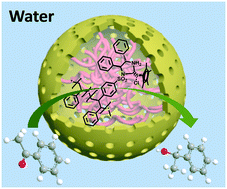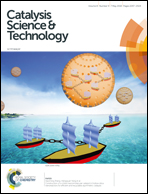Construction of a chiral macromolecular catalyst in hollow silica nanoreactors for efficient and recyclable asymmetric catalysis†
Abstract
The entrapment method is a fascinating pathway to convert homogeneous into heterogeneous catalysts. However, the types of entrapped catalysts and available supports are still limited because of the strict requirements of this method. Here, we reported a novel strategy for achieving efficient entrapment of a chiral homogeneous catalyst by forming macromolecular polymers in the cavity of hollow silica nanoreactors. Specifically, through in situ polymerization of the chiral ligand (1R,2R)-N1-(4-vinylbenzenesulfonyl)-1,2-diphenylethane-1,2-diamine (VBS-DPEN) with styrene followed by coordination of the metal precursor [Cp*RhCl2]2 (Cp* = pentamethylcyclopentadiene), a chiral solid catalyst with a confined macromolecular polymer was obtained. In the aqueous asymmetric transfer hydrogenation (ATH) of ketones, such a catalyst exhibited much better activity (TOF 991 vs. 724 h−1) and similar enantioselectivity (94% ee) compared with its homogeneous counterpart. This excellent activity can be attributed to the combination of the hollow mesoporous structure, unique hydrophobic@hydrophilic surface properties and semi-free state of the macromolecular catalyst. Moreover, the solid catalyst exhibits good recyclability, which is much better than the pure macromolecular polymer catalyst. Our studies not only provide an excellent heterogeneous asymmetric catalyst but also demonstrate that the pathway for confining macromolecules could be used as an efficient scaffold for the synthesis of entrapped catalysts.



 Please wait while we load your content...
Please wait while we load your content...